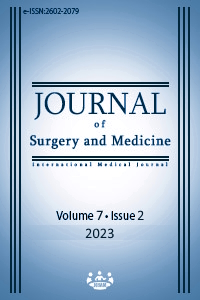Impact of prenatal physical preparation program on respiratory parameters of pregnant women
Prenatal physical preparation program for pregnant women
Keywords:
physical preparation, prenatal, pregnant women., spirometryAbstract
Background/Aim: Pregnancy is a condition that alters a woman's respiratory parameters. We aimed to verify the impact of a prenatal physical preparation program on respiratory parameters of pregnant women.
Methods: A quasi-experimental study was conducted with 38 pregnant women over a period of 8 months. It consisted of measuring the respiratory parameters (using the New MIR Spirolab Spirometer) of pregnant women who participated in the prenatal physical preparation program. Each session lasted 45 minutes and took place once a week. The sessions involved low to moderate intensity and assessed the forced expiratory volume second, the vital capacity force, and the peak expiratory flow.
Results: After the intervention program in prenatal physical preparation, there was a significant change in the vital capacity force (74 (3.65) before vs 79 (0.54) after; P=0.003); forced expiratory volume (68 (0.63) vs 76 (0.45), P=0.002); and peak expiratory (69 (1.77) before vs 78 (1.12) after; P=0.001) The Tiffeneau index showed (72.8 (4.2) vs 76.19 (13.3), P=0.001). The number of pregnant women with normal spirometry doubled from 47.4% at the start of the program to 94.7% at the end of the program. Similarly, the proportion of pregnant women with mild restriction increased from 42.1% at the start of the program to 2.6% at the end, indicating a total improvement of the obstructive disorders.
Conclusion: The regular practice of physical activity allows for improvement of the respiratory parameters of pregnant women. This program must continue to enable these women to maintain their respiratory capacity after childbirth.
Downloads
References
Biddle S, Goudas M. Sport, activité physique et santé chez l’enfant. 1994;47(2):135 44. DOI: https://doi.org/10.3406/enfan.1994.2094
ACOG Committee on Obstetric Practice. Committee opinion 267: exercise during pregnancy and the postpartum period. Obstet Gynecol. 2002 Jan 1;99(1):171–3. DOI: https://doi.org/10.1016/S0029-7844(01)01749-5
Clapp J, Seaward B, Sleamaker R, Hiser D. Maternal physiologic adaptations to early human pregnancy. Am J Obstet Gynecol. 1988;159(6):1456-60. DOI: https://doi.org/10.1016/0002-9378(88)90574-1
Gosling J. Anatomy and Physiology, Educational and Cultural Center. 1995;74(4):103-12.
Kamanga Mwamba B, Kayembe J, Nkiama Ekisawa C. Reference spirometric values in the Bantu population of Kinshasa. Pam. Afr Med J. 2019;5(3):33-42. DOI: https://doi.org/10.11604/pamj.2019.33.295.16843
Artal R, Mittelmark M. Physical changes during pregnancy. Saint Louis, University School of Medicine latest revised, 2021.
Khalid B. Reference values and predictive equations for spirometry in the Moroccan population. 2017;56(3):131-6.
Bourgrida M, Ben Saad H, Kheireddinne Bourahil M, Bougmiza I, Mehdioul H. Spirometric reference equations of Algerians aged 19 to 73 years. J Obstet. 2006;7(3):66-7.
Riemann MK, Kanstrup HI. Effects on the foetus of exercise in pregnancy. Scand J Med Sci Sports. 2000 Feb;10(1):12-9. DOI: https://doi.org/10.1034/j.1600-0838.2000.010001012.x
Downloads
- 348 510
Published
Issue
Section
How to Cite
License
Copyright (c) 2023 François Njimbu , Iness Bilo , Andy-Muller Nzinga , Teddy Bofosa , Eric Kam , Pompon Kazadi, Claude Cilumba , Naicha Lungungu , Vicky Lokomba , Roger Mbungu , Betty Miangindula
This work is licensed under a Creative Commons Attribution-NonCommercial-NoDerivatives 4.0 International License.
















